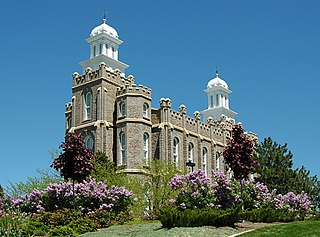
The Logan Utah Temple was completed in 1884, and is the fourth temple built by The Church of Jesus Christ of Latter-day Saints. Located in the city of Logan, Utah, it was the second temple built in the Rocky Mountains, after the St. George Temple, which remains the only LDS temple that has been in operation longer than the Logan Temple.

Miles Romney was an early English convert to Mormonism, Mormon pioneer and early settler of the American west, including St. George, Utah. In 1837, Romney and his wife, Elizabeth, joined the Church of the Latter Day Saints in a baptism ceremony just south of Preston, Lancashire, England. Soon after, they emigrated to the United States to join with the Church of Jesus Christ of Latter Day Saints in Nauvoo, Illinois.

The Jacob Hamblin House is a historic residence and museum located in Santa Clara, Utah, United States (near St. George. Jacob Hamblin was a Mormon pioneer and missionary who founded Santa Clara in 1854. After a flood destroyed the town, a group of missionaries constructed a new home for him on a hillside. It is now open as a museum.

The Brigham Young Winter Home and Office is a historic residence and museum located in St. George, Utah. Brigham Young was the foremost Mormon pioneer and led the church to the Utah Territory. As Young grew older, his arthritis precluded him from spending winters in the Salt Lake City region, so his followers built him a winter home in St. George in the arid Dixie region of Utah. Young seasonally occupied the home and office from 1873 to 1876. The building was eventually deeded to the division of Utah State Parks and Recreation and is now open as a museum.

The Samuel H. Allen Home is a historic house located at 135 E. 200 North in Provo, Utah. It is listed on the National Register of Historic Places.

The Simon Peter Eggertsen Sr. House is a historic house in Provo, Utah, United States. It is listed on the National Register of Historic Places. Now it has been repaired, repainted, and appointed with appropriate furnishings of the times, this home very much depicts pioneer design and craftsmanship. The Simon Peter Eggertsen Sr. House was designated to the Provo City Historic Landmarks Registry on March 7, 1996.
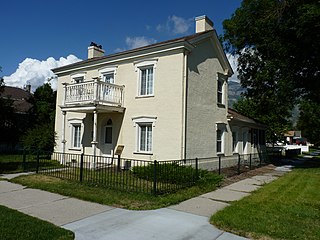
The Clark–Taylor House is a historic building located in Provo, Utah, United States. It is listed on the National Register of Historic Places. It has also been known as the T. N. Taylor Home. One of the oldest pioneer buildings in the state, the Clark–Taylor House was built around 1854. Thomas N. Taylor, a Provo Mayor, LDS bishop, and stake president, along with being a chairman of the board of trustees of BYU, lived in this home. The Clark–Taylor House was designated to the Provo City Historic Landmarks Registry on March 7, 1996.

The Peter Wentz House is a historic building located at 575 North University Avenue (US‑189) in northern downtown Provo, Utah, United States. It is listed on the National Register of Historic Places.

The Naegle Winery, also known as the Naile House, was built beginning in 1866 in Toquerville, Utah for German immigrant John C. Naegle, who moved to southern Utah after making a small fortune in gold panning in California. Naegle made sacramental wine for The Church of Jesus Christ of Latter-day Saints until wine was discontinued by the church in the late 19th century. The wine industry declined and the winery was converted to can figs, and later to process peaches.
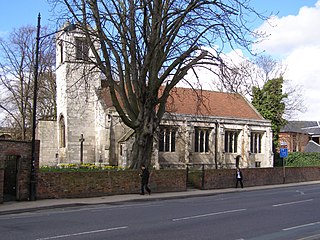
St Cuthbert's Church, Peasholme Green, York is a Grade I listed parish church in the Church of England in York now known as St Cuthbert's House of Prayer.
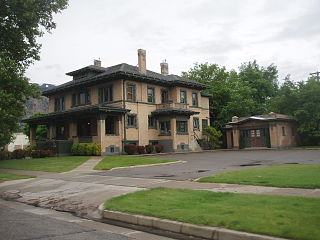
The Heber Scowcroft House is a historic two-story house in Ogden, Utah. It was built in 1909 for Heber Scowcroft, an immigrant from England who moved to Utah with his family in 1880 after converting to The Church of Jesus Christ of Latter-day Saints. Scowcroft later worked as the vice president of John Scowcroft and Son, a wholesale dry goods company founded by his father and based in the Scowcroft Warehouse. The house was designed in the Colonial Revival style by architect Moroni Charles Woods. It has been listed on the National Register of Historic Places since December 13, 1991.

The William D. Skeen House is a historic house in Plain City, Utah. It was built in 1862 for William D. Skeen, a Pennsylvania-born pioneer who converted to The Church of Jesus Christ of Latter-day Saints in 1850. Skeen had two wives: his first wife, Caroline, was an immigrant from England, while his second wife, Mary Davis, was an immigrant from Wales. The house was built with the help of two other Mormon pioneers: William Sharp, the stonemason, and Thomas Singleton, a carpenter. The house was purchased in 1868 by Ebenezer C. Richardson, who lived here with his four wives and 12 children. It has been listed on the National Register of Historic Places since August 9, 1982.

The William F. Butler House is a historic house in St. George, Utah. It was built as an adobe house in 1865 by William Franklin Butler, an early convert to The Church of Jesus Christ of Latter-day Saints. Butler first settled Palmyra, Utah with other Mormon converts in 1852 before moving to Spanish Fork, Utah, where he became a council member. In 1861, after President Brigham Young had asked them to, Butler moved to Southern Utah with more than 300 Mormon families and he became one of the first settlers of St. George. This house was built shortly after, and Franklin lived here with his two wives and many children. It was acquired and expanded by Henry G. Bryner, an immigrant from Switzerland and a Mormon convert, in 1886. It has been listed on the National Register of Historic Places since July 13, 1984.

The Rider-Pugh House is a historic house in Kanab, Utah. It was built in 1892-1894 by John Rider, an immigrant from Ireland who converted to The Church of Jesus Christ of Latter-day Saints in 1855 and settled in Utah in 1886. He was assisted by his son, Frank Rider. Rider initially lived near Salt Lake City with his wife, née Mary McDonald, and their two children. He moved to a fort in Kanab in 1870, and he purchased the plot of land upon which this house was built in 1889. The house designed in the Late Victorian style. Underneath the foyer, there is a "polygamy pit". In 1895, the house was acquired by Edward Pugh, an immigrant from England who also converted to the LDS Church and arrived in the United States in 1844. Pugh had two wives, Mary Ann Rock Williams and Elizabeth Kelly, although his first wife lived in Salt Lake City. The house was deeded to their daughter, Pearl Edna Pugh Brown, in 1914. It has been listed on the National Register of Historic Places since April 6, 2001.
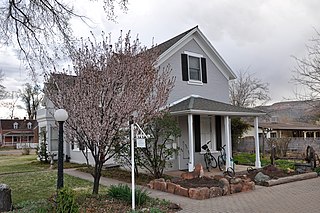
The Stewart-Woolley House is a historic house in Kanab, Utah. It was built in 1872 for Levi Stewart, who converted to The Church of Jesus Christ of Latter-day Saints with his family in Illinois in 1837. Stewart moved to Kanab in 1870, where he first stayed in an old fort. He built his house shortly after, and it was designed in the Gothic Revival and Late Victorian styles. Stewart served as the local bishop. The house was acquired by Edwin D. Woolley, a native of Nauvoo, Illinois, in 1889. Woolley had two wives, Emma Geneva Bentley, with whom he had twelve children, and Flora Ashby Snow, with whom he had nine children. He lived in this house with his first wife, Emma, and their children, including Mary E. Woolley Chamberlain, who served as the mayor of Kanab from 1911 to 1913. The house has been listed on the National Register of Historic Places since April 6, 2001.

The Niels Ole Anderson House is a historic house in Ephraim, Utah. It was built in 1868 for Niels Ole Anderson, an immigrant from Sweden whose parents converted to The Church of Jesus Christ of Latter-day Saints and settled in Utah in 1854–1855, when Anderson was ten years old. He served in the Black Hawk War in 1865. Anderson lived in this house, designed with elements of Greek Revival and Federal styles, with his first wife, Josephine Overglade, and their nine children. He served as a missionary in his native Sweden from 1880 to 1882. After his wife died in 1884, he married Matilda Nielson in 1885, and they had a son, Niels Henry. The house was inherited by his ancestors. It has been listed on the National Register of Historic Places since October 5, 1978.

The Cox-Shoemaker-Parry House is a historic two-story house in Manti, Utah. It was built in 1858 by Orville Southerland Cox, who converted to The Church of Jesus Christ of Latter-day Saints in Illinois, where he was baptized by Joseph Smith in 1839. Cox later served as the bishop of Bountiful, Utah, and he settled in Sanpete County in 1849. He became a counselor to Bishop John Lowery, Sr., in Manti, and he lived in this house with his three wives: Elvira Mills, Mary Allen, and Eliza J. Losee.

The Morten Rasmussen House is a historic two-story house in Mount Pleasant, Utah. It was built with red bricks in 1875 by Morten Rasmussen, an immigrant from Denmark who converted to The Church of Jesus Christ of Latter-day Saints and arrived in Ephraim, Utah in 1851, before moving to Mount Pleasant with other Mormon settlers in 1859. Rasmussen lived in this house, designed in the Federal architectural style, with his wife, née Karen Marie Christiansen, also an immigrant from Denmark, and their twelve children. He was a missionary in his native Denmark from 1881 to 1883, and he died in 1885. The house has been listed on the National Register of Historic Places since August 18, 1977.

The Robert Johnson House is a historic two-story house in Manti, Utah. It was built with limestone in 1860 by Robert Johnson, an immigrant from England who converted to The Church of Jesus Christ of Latter-day Saints and settled in Utah in 1853. He became a prosperous farmer in Manti. The house has been listed on the National Register of Historic Places since October 14, 1980.

The Jabez Faux House and Barn is a historic two-story house and a barn in Moroni, Utah. It was built in 1867 by Jabez Faux (b.1837), an immigrant from Yorkshire, England who converted to The Church of Jesus Christ of Latter-day Saints and settled in Moroni in 1860. He built a dugout, then later a log cabin, then eventually this house in which he lived for more than 55 years. Faux was a blacksmith and a farmer, and he served on the board of the Moroni Cooperative Mercantile Institution.

















